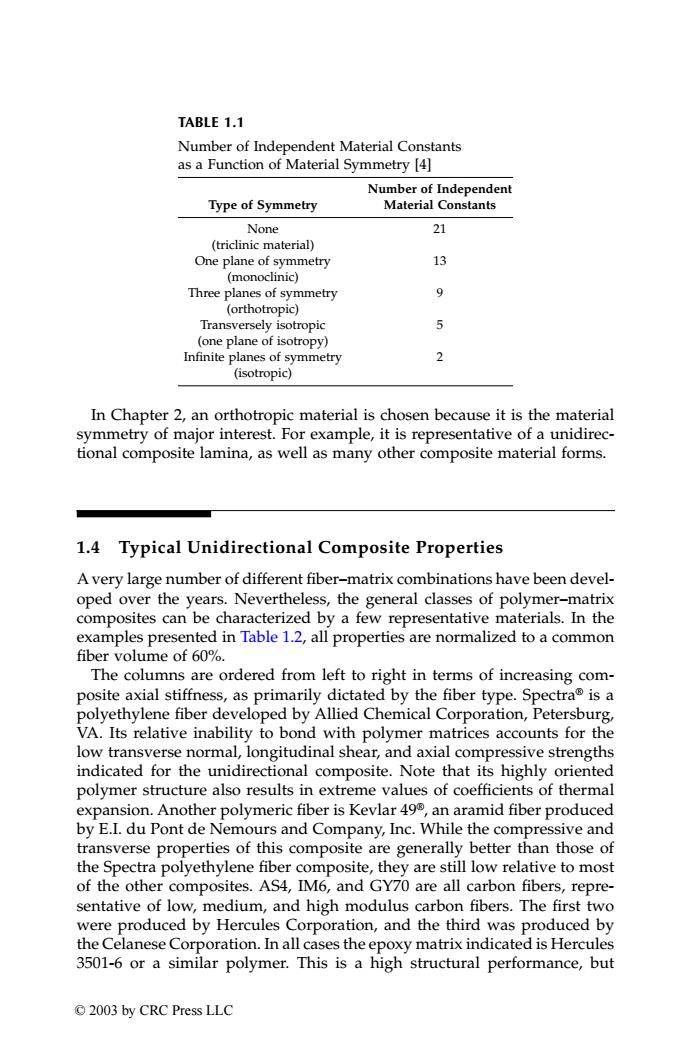正在加载图片...

TABLE 1.1 Number of Independent Material Constants as a Function of Material Symmetry [4] Number of Independent Type of Symmetry Material Constants None 21 (triclinic material) One plane of symmetry 13 (monoclinic) Three planes of symmetry 9 (orthotropic) Transversely isotropic 5 (one plane of isotropy) Infinite planes of symmetry 2 (isotropic) In Chapter 2,an orthotropic material is chosen because it is the material symmetry of major interest.For example,it is representative of a unidirec- tional composite lamina,as well as many other composite material forms. 1.4 Typical Unidirectional Composite Properties A very large number of different fiber-matrix combinations have been devel- oped over the years.Nevertheless,the general classes of polymer-matrix composites can be characterized by a few representative materials.In the examples presented in Table 1.2,all properties are normalized to a common fiber volume of 60%. The columns are ordered from left to right in terms of increasing com- posite axial stiffness,as primarily dictated by the fiber type.Spectra is a polyethylene fiber developed by Allied Chemical Corporation,Petersburg, VA.Its relative inability to bond with polymer matrices accounts for the low transverse normal,longitudinal shear,and axial compressive strengths indicated for the unidirectional composite.Note that its highly oriented polymer structure also results in extreme values of coefficients of thermal expansion.Another polymeric fiber is Kevlar 49,an aramid fiber produced by E.I.du Pont de Nemours and Company,Inc.While the compressive and transverse properties of this composite are generally better than those of the Spectra polyethylene fiber composite,they are still low relative to most of the other composites.AS4,IM6,and GY70 are all carbon fibers,repre- sentative of low,medium,and high modulus carbon fibers.The first two were produced by Hercules Corporation,and the third was produced by the Celanese Corporation.In all cases the epoxy matrix indicated is Hercules 3501-6 or a similar polymer.This is a high structural performance,but ©2003 by CRC Press LLCIn Chapter 2, an orthotropic material is chosen because it is the material symmetry of major interest. For example, it is representative of a unidirectional composite lamina, as well as many other composite material forms. 1.4 Typical Unidirectional Composite Properties A very large number of different fiber–matrix combinations have been developed over the years. Nevertheless, the general classes of polymer–matrix composites can be characterized by a few representative materials. In the examples presented in Table 1.2, all properties are normalized to a common fiber volume of 60%. The columns are ordered from left to right in terms of increasing composite axial stiffness, as primarily dictated by the fiber type. Spectra® is a polyethylene fiber developed by Allied Chemical Corporation, Petersburg, VA. Its relative inability to bond with polymer matrices accounts for the low transverse normal, longitudinal shear, and axial compressive strengths indicated for the unidirectional composite. Note that its highly oriented polymer structure also results in extreme values of coefficients of thermal expansion. Another polymeric fiber is Kevlar 49®, an aramid fiber produced by E.I. du Pont de Nemours and Company, Inc. While the compressive and transverse properties of this composite are generally better than those of the Spectra polyethylene fiber composite, they are still low relative to most of the other composites. AS4, IM6, and GY70 are all carbon fibers, representative of low, medium, and high modulus carbon fibers. The first two were produced by Hercules Corporation, and the third was produced by the Celanese Corporation. In all cases the epoxy matrix indicated is Hercules 3501-6 or a similar polymer. This is a high structural performance, but TABLE 1.1 Number of Independent Material Constants as a Function of Material Symmetry [4] Type of Symmetry Number of Independent Material Constants None (triclinic material) 21 One plane of symmetry (monoclinic) 13 Three planes of symmetry (orthotropic) 9 Transversely isotropic (one plane of isotropy) 5 Infinite planes of symmetry (isotropic) 2 TX001_ch01_Frame Page 8 Saturday, September 21, 2002 4:47 AM © 2003 by CRC Press LLC